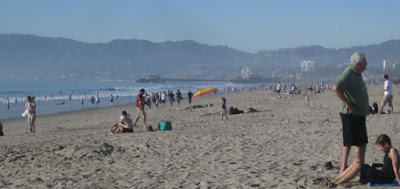
The workers were here at 9am and finished up the ceiling.
I got a call from my friend B - he wanted to bike to Palos Verdes, starting around Redondo Beach. It was sunny and beautiful and getting out of the house so the workers could do their thing without me around seemed like a great idea.
As we cruised around the beach cities looking for a parking spot, we entered the fog. Low, grey clouds.
Here's a shot of it.

And it was chilly. A very damp, low 60s. (I know, chilly is relative.) After a bit we needed to get off the beach bike path and head up hills through Torrance. I stopped partway up the hill to watch the fog roll up from the ocean.
As we got further up, the sun was visible, sort of.

And then as we rode higher, we got above the fog. There's Palos Verdes above us, visible.

And this, I'm pretty sure, is Malaga Bay. You can see the wall of fog sitting there waiting over the ocean. There were 20-30 surfers out in the waves below.
But soon we were in the fog again. B kept checking the map on his phone to see how much further it was. I didn't actually know what 'it' was, except "Palos Verdes." As far as I was concerned, we were already in PV. Should we go the rest of the way?, B asked me. I told him I didn't know where we were going or why it would be worth the extra three miles uphill. I was also thinking about the two foot wide bike path on the other side of the street and the cars whizzing by. Our side had about ten feet of parking area that was also a bike lane. Finally B said it was Terra something resort. Then I remembered I'd just read about them hiring foreign interns and using them to replace their minimum wage workers. Human trafficking was in the headline. I didn't need to go there. B suggested I might interview some of the workers for the blog. I was thinking about when it gets dark in LA (early - about 5:30pm in late December). We went a little further and turned around.
We'd gone about nine miles. After about a mile my bike was getting very sluggish and making a strange noise. When I looked down I could see my back tire was flat. We found the nail. B's repair kit wasn't working - no patches and his hand pump didn't work on my valve stem. I told B to ride ahead to the car and I'd walk as far as I could and he could pick me up. We were about eight miles from the car. He wanted me to turn my bike upside down so people could see we were in trouble, and he'd hitch a ride in a pick up truck. I'm not sure why I didn't want to. I guess I was embarrassed that I didn't have stuff with me to fix the flat.
Five minutes, that's all B wanted, then we could go with my plan.
After four minutes I was ready to start walking, then a pick up stopped. B ran and talked to the driver and soon the bikes were in the bed and we were in front with Steve Lavine who had been out for a walk. He used to run and bike and hike, but he had various health issues now and it was even a struggle to walk. We met a new friend who took us all the way back to the car. He said he was headed our way anyway and it wasn't too far extra. B was pleased to have been right and I wasn't upset I was wrong.
 |
Thanks, Steve, for ending our bike ride with a spectacular show of good will. Getting a ride back was great, but getting to know a total stranger who'd stop and pick up two guys with bikes was even better.
I'm not that surprised, but we do get jaded by our media that tends to focus on the tiny number of people who do harm each day rather than on the 350 million other US inhabitants who are like Steve Lavine.











































